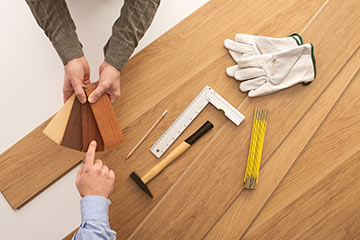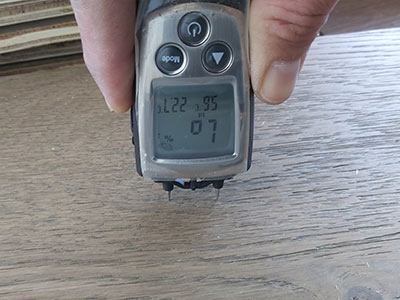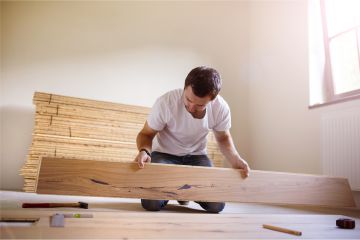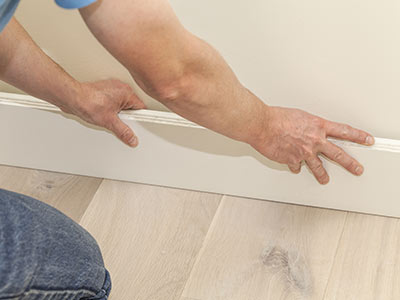Back to Wood Floor Fitting
Wood Flooring Installation Tips
Installing wood flooring is an exciting and rewarding project, but it can also be a daunting one. Wood floors are not easy to install, and if you don’t do it right, you could end up with warped or damaged boards that need to be replaced. To ensure that your project goes smoothly from start to finish, here are some tips for installing wood flooring the right way. With these tips in mind, you can guarantee beautiful results without any of the common problems associated with wood floor fitting.
Preparation and Planning
Flooring installation requires proper preparation and planning to ensure successful results. One of the critical stages is accurately measuring the room to determine the amount of flooring material needed. Measuring the room also helps in determining the direction of installation, which impacts the overall aesthetic appeal of the floor. Determining the subfloor condition is an essential step since any flaws or issues can lead to uneven surfaces and damage to the new flooring material. Clearing the room of furniture and debris is also necessary before installation to provide ample space for the installers to work and make their job easier.
Removing furniture and appliances from the room also protects them from any potential damage or debris generated during the installation process. It is important to ensure that the subfloor is clean before laying the new flooring. Deciding to install new flooring can add value and appeal to a home or business, but you must plan before installation to ensure you achieve the best possible results. A properly done installation will not only enhance the aesthetic appeal of the room but also increase its functionality. Having a professional installer to oversee the floor fitting process is also necessary to ensure every stage is done appropriately and to a high standard.
Choosing the Right Wood Flooring

When choosing the right wood flooring, several factors should be considered to ensure the desired outcome. The choice of wood species should be based on its specific characteristics, such as colour, hardness, and grain pattern. Some species, such as oak or maple, are more common for their durability and versatility, whereas others, such as cherry or walnut, are selected for their unique appearance. Similarly, the plank width and thickness should be selected according to the room size, design style, and expected traffic.
Thicker planks provide greater stability and insulation, while wider planks create a more rustic look and feel. The finishes available for wood flooring include oil-based, water-based, and polyurethane, each with its advantages and drawbacks. Oil-based finishes offer a more natural and warm look but may require more maintenance, while water-based finishes provide more protection and durability, but can be less forgiving to repair. Balancing aesthetic preferences with durability requirements is crucial to ensuring that the wood floor will not only look beautiful but also withstand the wear and tear of everyday life. It is important to choose the flooring that not only complements your design tastes but also meets your lifestyle needs.
Subfloor Preparation
Subfloor preparation is a crucial step in any flooring installation process. The subfloor must be clean, level, and dry before installing any new flooring. The first step is to ensure that any debris, dirt, or existing flooring has been removed from the subfloor thoroughly. Once cleaned, any damage or unevenness in the subfloor must be repaired, or it may result in noticeable lumps or bumps in your new flooring. If there are any moisture issues present, they must also be addressed before installation to prevent any future damage to your flooring. This can be done by checking and fixing any leaks, using a moisture barrier, or improving ventilation in the area. If necessary, an underlayment should be installed between the subfloor and the new flooring. Underlayment helps to protect the flooring above and helps to create a level surface. Proper subfloor preparation ensures a stable and durable foundation for your flooring that will last for many years to come.
Acclimating the Wood Flooring

Acclimating wood flooring is an important process that ensures the longevity and durability of the flooring. The first step in acclimation is allowing the wood to adjust to the room's humidity and temperature. This is critical in avoiding any adverse changes in the moisture content of the wood, which could cause it to expand or contract, leading to gaps or buckling. It is important to unpack and store the flooring planks properly. This means avoiding any exposure to moisture or direct sunlight. Following the manufacturer's guidelines for the acclimation period is key.
Typically, the recommended acclimation period for hardwood flooring is around 3 to 5 days. It's crucial to monitor moisture levels during the acclimation process using moisture meters to ensure that the wood has adjusted correctly. This process is especially important when installing hardwood flooring in a new construction project, where the humidity levels can be much higher than normal. By properly acclimating the wood flooring, you ensure that the installation process goes smoothly and guarantee that your floors will last for decades to come.
Tools and Materials Needed
Specific tools and materials are needed to achieve a successful and long-lasting result. Essential tools for wood flooring installation include a measuring tape, hammer, saw, pry bar, and a level. Gathering required materials, such as nails, adhesives, or spacers, will depend on the flooring type and installation method. For solid hardwood flooring, a pneumatic flooring nail gun or manual nailer, as well as wood glue, is necessary. Certain installation methods may require speciality tools, such as a jigsaw, circular saw, or pull bar, to aid in cutting or aligning the flooring. Safety equipment is also crucial to have on hand, including goggles to protect against flying debris and knee pads for a more comfortable installation experience. It is essential to prioritise safety during floor installation, especially when it comes to power tools. The right tools and materials, along with safety equipment, will make the installation process more comfortable and efficient, ensuring a beautiful finished product.
Installation Techniques: Nail Down, Glue Down, or Floating

When it comes to installing new flooring, there are three popular techniques: Nail Down, Glue Down, or Floating. Understanding the advantages and disadvantages of each method is essential to choosing the right one for your floors.
Nail-down installation requires a solid subfloor and the use of nails as fasteners. It is ideal for hardwood floors, as it provides stability and durability, but it can be noisy and dust-producing during the installation process.
Glue down, on the other hand, is great for vinyl and carpet tiles, but it requires a clean and dry subfloor, as well as a recommended adhesive to ensure proper adhesion.
Floating installation is the easiest method, as it does not require any fasteners or adhesives. Instead, it uses interlocking systems to hold the flooring in place. It is perfect for laminate flooring, but it can be less stable and less durable than the other two methods.
No matter which installation method you choose, it is crucial to follow the recommended techniques for each. This will ensure a safe and reliable installation process that will last for years to come. Using appropriate fasteners or adhesives is essential for the selected technique. For example, nails must be the right size and gauge for the subfloor and the flooring material, while glue must be compatible with the type of flooring and the subfloor. Finally, adhering to the manufacturer's instructions for each method is vital to prevent any potential issues or errors. By doing so, you can guarantee that your floors will look and perform their best.
Cutting and Fitting the Wood Flooring
Cutting and fitting wood flooring requires careful attention to detail to ensure a professional and polished look. Measuring and marking planks before cutting is essential for accuracy and minimising mistakes. Choosing the appropriate saws or tools for cutting is another critical factor, as different types of wood require different tools to ensure a clean cut. When fitting planks around obstacles like door frames and vents, precision is key to ensure a tight fit and prevent unsightly gaps. Proper spacing and alignment between planks are also crucial for creating a uniform and visually appealing look. All of these factors combined make for a challenging but rewarding project that can transform any space into a warm and welcoming retreat. Taking the time to carefully plan and execute each step will result in a beautiful and functional finished product that will last for many years to come.
Dealing with Obstacles and Tricky Areas
Dealing with obstacles and tricky areas can be one of the most challenging parts of any home renovation project. There are a number of strategies that can be used to help work around irregularly shaped rooms. One common approach is to create a focal point in the room, such as a fireplace or dramatic artwork, that can help to draw attention away from the shape of the space. When it comes to handling transitions between different flooring materials, it's important to think carefully about the materials themselves and how they will work together visually. Using a threshold strip can help create a smooth transition between two different types of flooring.
Addressing challenging areas like stairs or curved surfaces might require a little more creativity. In some cases, it might be necessary to bring in specialised tradespeople or contractors to help manage these tricky areas. Overcoming obstacles such as radiators or built-in furniture can be equally challenging. One strategy is to work around these features, building new cabinetry or walls to help create a more seamless and integrated look. By thinking creatively and approaching each obstacle or tricky area as an opportunity for innovation, homeowners can still achieve the renovation project of their dreams.
Installing Baseboards and Trim

Installing baseboards and trim is the final touch that can make all the difference in a room's finished look. Choosing suitable moulding or trim is essential to ensure a cohesive style and finish. Once the appropriate trim has been selected, the next step is to measure and cut the baseboards or quarter-rounds to the correct length. It is very important to ensure proper spacing and alignment with the flooring to avoid any awkward gaps or unevenness.
After installing the trim, it is essential to fill the nail holes and caulk any gaps between the trim and the wall or flooring. This helps to create a seamless finish and ensure that the trim is secure. Applying a final finish is another vital step in the installation process. The finish can be a coat of paint or a stain that complements the surrounding decor and enhances the aesthetic appeal of the room. By following these steps, you can create a polished and professional look that elevates the overall style of your home. With a little patience and attention to detail, you can easily install baseboards and trim and transform your space.
Troubleshooting Common Installation Issues
Installing wood flooring can be a great way to add beauty and value to your home, but it can also come with its share of installation challenges. Some of the most common issues that homeowners may encounter during the installation process include buckling or warping of the wood, squeaky or loose boards, as well as damaged or stained areas. To address these issues, you may need to take different approaches depending on the severity of the problem. For buckling or warping, it is essential to identify the cause of the issue, which can be anything from moisture to improper installation.
Squeaky or loose boards can often be resolved by using screws or adhesive to secure them, while damaged or stained areas may require sanding, staining, or replacement of damaged planks. In more complex or severe cases, it is recommended to seek the help of a professional flooring contractor. They have the experience and expertise to diagnose the problem and provide effective solutions that ensure the longevity and beauty of your wood flooring. By troubleshooting these common installation issues, you can enjoy the benefits of a beautiful, long-lasting wood floor in your home.
Want flawless results for your wood floor installation? Whether you're planning a DIY project or looking for expert support, our team at FlooringFirst! is here to help. Book a free site visit or contact us today to get professional advice, product recommendations, and precision installation across London.